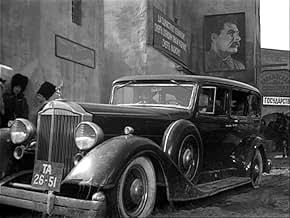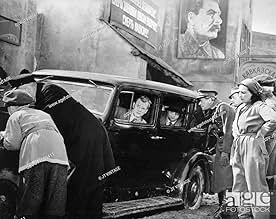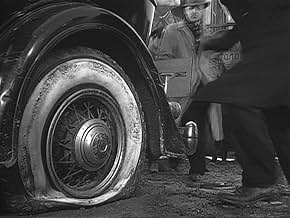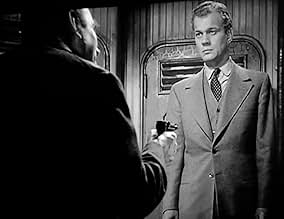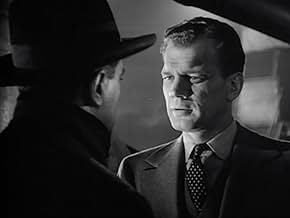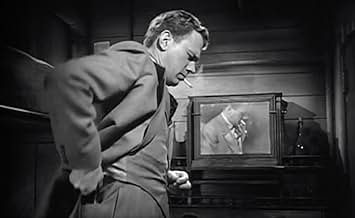CALIFICACIÓN DE IMDb
6.5/10
5 k
TU CALIFICACIÓN
Un experto estadounidense en balística en Turquía es blanco de agentes alemanes. Se le ha organizado un viaje seguro a casa en barco, pero pronto descubre que sus perseguidores también están... Leer todoUn experto estadounidense en balística en Turquía es blanco de agentes alemanes. Se le ha organizado un viaje seguro a casa en barco, pero pronto descubre que sus perseguidores también están a bordo.Un experto estadounidense en balística en Turquía es blanco de agentes alemanes. Se le ha organizado un viaje seguro a casa en barco, pero pronto descubre que sus perseguidores también están a bordo.
- Dirección
- Guionistas
- Elenco
Dolores Del Río
- Josette Martel
- (as Dolores Del Rio)
Anna De Linsky
- Russian Maid at Batumi Hotel
- (sin créditos)
Jerome de Nuccio
- Turkish Officer
- (sin créditos)
Herbert Drake
- Ship's Steward
- (sin créditos)
Opiniones destacadas
Joseph Cotten plays an American armaments engineer on the run from the Nazis in "Journey into Fear," a 1943 film with a script by Cotten (from a story by Eric Ambler) and costarring Orson Welles and Delores del Rio. Cotten is working on a deal to supply Turkey with weapons to fight the Axis. The Nazis don't want the deal made and are trying to stop Cotten from getting back to the U.S.
There are some very exciting scenes in this extremely atmospheric film, in particular on the ledge of a building between Cotten and the terrifying assassin. Most of the film takes place on board a dingy ship where Cotten is taken, thus beginning his Kafka-esquire nightmare.
This is an entertaining film for sure, but I've always been troubled by it. First of all, it seems like there are scenes missing. Second, it's on the confusing side since there are irrelevant characters thrown in. Third, you can drive a truck through some of the plot holes. Fourth, the ending to me has always felt abrupt.
Suspenseful? Yes. Intriguing? Yes. Ultimately disappointing? Yes. Cotten is good as a man blundering through something he can't quite figure out - the problem is, the audience can't quite figure it out either. Welles has a small but effective role as Dr. Haki.
Strong on style, weak on substance.
There are some very exciting scenes in this extremely atmospheric film, in particular on the ledge of a building between Cotten and the terrifying assassin. Most of the film takes place on board a dingy ship where Cotten is taken, thus beginning his Kafka-esquire nightmare.
This is an entertaining film for sure, but I've always been troubled by it. First of all, it seems like there are scenes missing. Second, it's on the confusing side since there are irrelevant characters thrown in. Third, you can drive a truck through some of the plot holes. Fourth, the ending to me has always felt abrupt.
Suspenseful? Yes. Intriguing? Yes. Ultimately disappointing? Yes. Cotten is good as a man blundering through something he can't quite figure out - the problem is, the audience can't quite figure it out either. Welles has a small but effective role as Dr. Haki.
Strong on style, weak on substance.
Howard Graham is an American engineer returning from Istanbul with his wife Stephanie. A close call in a Turkish nightclub sees a man assassinated by mistake when really Howard was the target and he and his wife are quickly taken to the Turkish secret police. Colonel Haki informs him that he is a target of the Nazis and immediately gets him transit out of the country on the next available boat while he protects his wife. However Howard quickly finds that he is far from being out of danger as his pursuers are on the boat as well.
With keys part of the Third Man cast involved in this thriller, I decided to take a look and had hoped for a film that perhaps would be as enjoyable as that. However it was not quite all that I hoped it would have been as I didn't find myself that gripped by it. The early scenes suggest a real mystery with a good pace but quickly the mistaken assassination of the magician is slowed down and complicated by unnecessary characters and dialogue, some of which seemed to serve very little purpose other than setting up some other scenes later on. With Mrs Howard away somewhere out of vision and therefore out of mind, we focus on the action on other boat and, although quite tense at points, it didn't have the sort of sustained tension that should have been made easier by the confined location of the boat. It does enough to engage though and I did find it quite enjoyable but those claiming this as a classic up there with some of Welles' other films are mistaken because this is only quite good not any more than that.
The cast was the reason I was here but they were not as good as they have been in other films. Cotton is a bit brash and loud and aspects of his character aren't brought out that well; he was still an interesting leading man but mainly because I have always liked him. Welles has a small role and seems to enjoy himself playing a role that has little screen time but is mentioned throughout the film; I'm not sure if he did direct his own scenes but that is the rumour. Del Rio is sexy and a nice presence but I wasn't overly taken by her other than that. Moss tends to steal the film with his big character lurking around early on, meanwhile the rest of the support are OK, with other languages being spoken rather than the usual American actors putting on vague accents as was often the case (and still is!). Assuming that he did direct the majority, if not all, of the film (and I do believe this) Foster does a very good job of working with shadows in early scenes and in the boat some of his angles are effective, although it is easy to see (with some of his shots) why people generally believe that it was Welles calling the shots.
Overall this is an enjoyable thriller with a dark atmosphere brought out by good direction throughout. The cast are OK but none of the famous faces really stood out for me here, meanwhile the plot was not as tight as it needed to be, leaving some holes and using some distracting plot devices along the way. Still worth seeing but not the classic that it is often touted around as being.
With keys part of the Third Man cast involved in this thriller, I decided to take a look and had hoped for a film that perhaps would be as enjoyable as that. However it was not quite all that I hoped it would have been as I didn't find myself that gripped by it. The early scenes suggest a real mystery with a good pace but quickly the mistaken assassination of the magician is slowed down and complicated by unnecessary characters and dialogue, some of which seemed to serve very little purpose other than setting up some other scenes later on. With Mrs Howard away somewhere out of vision and therefore out of mind, we focus on the action on other boat and, although quite tense at points, it didn't have the sort of sustained tension that should have been made easier by the confined location of the boat. It does enough to engage though and I did find it quite enjoyable but those claiming this as a classic up there with some of Welles' other films are mistaken because this is only quite good not any more than that.
The cast was the reason I was here but they were not as good as they have been in other films. Cotton is a bit brash and loud and aspects of his character aren't brought out that well; he was still an interesting leading man but mainly because I have always liked him. Welles has a small role and seems to enjoy himself playing a role that has little screen time but is mentioned throughout the film; I'm not sure if he did direct his own scenes but that is the rumour. Del Rio is sexy and a nice presence but I wasn't overly taken by her other than that. Moss tends to steal the film with his big character lurking around early on, meanwhile the rest of the support are OK, with other languages being spoken rather than the usual American actors putting on vague accents as was often the case (and still is!). Assuming that he did direct the majority, if not all, of the film (and I do believe this) Foster does a very good job of working with shadows in early scenes and in the boat some of his angles are effective, although it is easy to see (with some of his shots) why people generally believe that it was Welles calling the shots.
Overall this is an enjoyable thriller with a dark atmosphere brought out by good direction throughout. The cast are OK but none of the famous faces really stood out for me here, meanwhile the plot was not as tight as it needed to be, leaving some holes and using some distracting plot devices along the way. Still worth seeing but not the classic that it is often touted around as being.
The ingredients are there for first-class international intrigue—Welles, Cotten, an Ambler novel, and the terrific RKO team of D' Agostino and Silvera behind so much of the studio's b&w artistry. So why is the end result short of the classic it should be. IMDb lists 3 uncredited writers in addition to the credited Cotten. Maybe that's why the narrative is so choppy as other reviewers point out. Then too, maybe the studio exercised a heavy hand in the editing room as they were known to do. Whatever the reason, the story never really gels into the suspenser it should be, despite the impressive visuals so clearly Wellsian.
Nonetheless, the nightclub scene especially stays with me. Catch the neatly choreographed staging as the characters dart in and out of the foreground reminiscent of the high-kicking dance scene in Citizen Kane. And who else but a magician (Hans Conreid) would trick himself into a casket with such Wellsian flourish. Note too how visually appropriate non- actor Jack Moss is as the "obese gunman". Apparently, he couldn't be entrusted with any lines, but looking like a mutant garden slug he rivets the eye by sinister presence alone. In fact, this may be the kind of film made more enjoyable by turning down the sound and just reveling in the visuals. Yes indeed, the narrative may disappoint, but the very real Wellsian compensations remain.
Nonetheless, the nightclub scene especially stays with me. Catch the neatly choreographed staging as the characters dart in and out of the foreground reminiscent of the high-kicking dance scene in Citizen Kane. And who else but a magician (Hans Conreid) would trick himself into a casket with such Wellsian flourish. Note too how visually appropriate non- actor Jack Moss is as the "obese gunman". Apparently, he couldn't be entrusted with any lines, but looking like a mutant garden slug he rivets the eye by sinister presence alone. In fact, this may be the kind of film made more enjoyable by turning down the sound and just reveling in the visuals. Yes indeed, the narrative may disappoint, but the very real Wellsian compensations remain.
The operatic approach of adding a musical dimension to menace with a killer-theme on the soundtrack has been greatly used in Orson Welles' glorious suspense film, "Journey Into Fear," where the little killer obsessively played a scratchy old 78 rpm disc of someone singing "Chagrin d'Amour."
The assassin was short and fat; his belly large, his chin and neck flabby... I do not recall him having a line of dialog to speak But the whole film was spread with heightened menace when he sat, his little round eyes blank behind his little round pebble lenses, listening compulsively to the atrociously scratchy record, confusing the words of the song at the wrong speed, the needle jumping from groove to groove; his nerve-ends, unlike ours, immune to the discordance
This was a spy thriller set in the wartime Near East, about an innocent American engineer (Joseph Cotten), pursued by Nazi agents and blundering from danger to danger without seeming to know too much of what it was all about It was essentially a hunter-and-hunted story, with settings that were often seedy but always exotic
The opening was in Istanbul, the climax in Batum, and all the terrors between were forced claustrophobically between the low ceilings and narrow partitions of a neglected little steamer plowing the Black Sea
"Journey Into Fear" lives for its portrait gallery, its atmosphere, and for Welles' touches and excesses
The assassin was short and fat; his belly large, his chin and neck flabby... I do not recall him having a line of dialog to speak But the whole film was spread with heightened menace when he sat, his little round eyes blank behind his little round pebble lenses, listening compulsively to the atrociously scratchy record, confusing the words of the song at the wrong speed, the needle jumping from groove to groove; his nerve-ends, unlike ours, immune to the discordance
This was a spy thriller set in the wartime Near East, about an innocent American engineer (Joseph Cotten), pursued by Nazi agents and blundering from danger to danger without seeming to know too much of what it was all about It was essentially a hunter-and-hunted story, with settings that were often seedy but always exotic
The opening was in Istanbul, the climax in Batum, and all the terrors between were forced claustrophobically between the low ceilings and narrow partitions of a neglected little steamer plowing the Black Sea
"Journey Into Fear" lives for its portrait gallery, its atmosphere, and for Welles' touches and excesses
Orson Welles graciously denied having any directing role in Norman Foster's 'Journey into Fear (1943),' though his influence appears to be all over it. 'Citizen Kane (1941)' first showcased Welles' fondness for filming people via low and high-angled cameras, a stylistic technique that distorts statures, placing the audience in a position either of power or helplessness. Here, the talented Karl Struss who also worked on such films as 'Sunrise: A Song of Two Humans (1927)' and 'Dr. Jekyll and Mr. Hyde (1931)' employs similar techniques, capturing human faces with a threatening immediacy that distorts their features and suggests imminent danger. You won't, of course, fail to notice that the film's cast also boasts more than a few Welles regulars, mostly members of his Mercury Theatre team Joseph Cotten, Agnes Moorehead, Everett Sloane, Ruth Warrick and Welles himself. The film's screenplay was written by Cotten, his sole attempt at writing {outside some uncredited work on 'The Magnificent Ambersons (1942)'}, a pity since the dialogue is frequently crisp, intelligent and memorable.
'Journey into Fear' is one of those rare WWII-themed films of the early 1940s that you wouldn't automatically class as propaganda. Indeed, the Nazis are only mentioned in passing, and the sinister agents who attempt to assassinate Cotten could just as easily be motivated by reasons other than war. Much of the story takes place on a small passenger ship, on which American engineer Howard Graham (Cotten) seeks refuge from German assassins, who are hell-bent on delaying his return home with important Allied intelligence. Silent enemy Peter Banat (played by Welles' agent, Jack Moss) watches ominously from across the ship's cabin, never saying a word, but suggesting sadistic menace through every dryly-amused smirk. Cotten is strong in the lead role, playing Graham as a frightened and confused amateur, a role reminiscent of Holly Martins from 'The Third Man (1949),' rather than the experienced and resourceful American spy we would otherwise expect in such a film. Welles lends his mighty presence to the role of the Turkish Colonel Haki, though he is noticeably more subdued than usual.
In one final manner, 'Journey into Evil' is very much like an Orson Welles film: it was re-edited at the studio's request. According to some sources, Welles did some of the trimming himself, recutting the final reel and adding Joseph Cotten's rather awkward narration. At just 68 minutes in length, the film certainly feels as though it has been tampered with. The relationship between Graham and Rosette (Dolores del Rio) is brief and poorly explored, and certainly not worthy of the repeated reassurances that the former frequently bestows upon his anxious wife (Ruth Warrick); there's little indication that the their affiliation extended beyond exchanging a few harmless pleasantries. Though the film doesn't exactly feel incomplete as did a noir like Renoir's 'The Woman on the Beach (1947)' the bare-bones narrative gives the sense of a minor and inconsequential work. Even so, 'Journey into Evil' is well worth seeking out for its terrific photography including a superb climax on the slippery ledges of a hotel exterior and the talents of a very talented cast.
'Journey into Fear' is one of those rare WWII-themed films of the early 1940s that you wouldn't automatically class as propaganda. Indeed, the Nazis are only mentioned in passing, and the sinister agents who attempt to assassinate Cotten could just as easily be motivated by reasons other than war. Much of the story takes place on a small passenger ship, on which American engineer Howard Graham (Cotten) seeks refuge from German assassins, who are hell-bent on delaying his return home with important Allied intelligence. Silent enemy Peter Banat (played by Welles' agent, Jack Moss) watches ominously from across the ship's cabin, never saying a word, but suggesting sadistic menace through every dryly-amused smirk. Cotten is strong in the lead role, playing Graham as a frightened and confused amateur, a role reminiscent of Holly Martins from 'The Third Man (1949),' rather than the experienced and resourceful American spy we would otherwise expect in such a film. Welles lends his mighty presence to the role of the Turkish Colonel Haki, though he is noticeably more subdued than usual.
In one final manner, 'Journey into Evil' is very much like an Orson Welles film: it was re-edited at the studio's request. According to some sources, Welles did some of the trimming himself, recutting the final reel and adding Joseph Cotten's rather awkward narration. At just 68 minutes in length, the film certainly feels as though it has been tampered with. The relationship between Graham and Rosette (Dolores del Rio) is brief and poorly explored, and certainly not worthy of the repeated reassurances that the former frequently bestows upon his anxious wife (Ruth Warrick); there's little indication that the their affiliation extended beyond exchanging a few harmless pleasantries. Though the film doesn't exactly feel incomplete as did a noir like Renoir's 'The Woman on the Beach (1947)' the bare-bones narrative gives the sense of a minor and inconsequential work. Even so, 'Journey into Evil' is well worth seeking out for its terrific photography including a superb climax on the slippery ledges of a hotel exterior and the talents of a very talented cast.
¿Sabías que…?
- TriviaThe great stage actor Richard Bennett had been brought back to films by Orson Welles for Soberbia (1942). Although his performance as old Major Amberson has become legendary, it was achieved with great difficulty, as Bennett, by then an old man near death, found it hard to remember his lines, and his eyesight was too poor for him to be able to read cue-cards. Welles's patience in dealing with these problems has been widely described. When he cast Bennett as the ship's captain, he overcame the problems simply by giving Bennett no dialogue at all, although the character has several memorable scenes. It was Bennett's final film role.
- ErroresDuring the chase outside the hotel in the rain, Banat's pistol, a P-08 "Luger" runs out of ammunition, but the action closes normally after he fires the last shot. This particular pistol was designed so that the action stays open after the last round is fired, giving a clear indication to the user that the gun is empty.
- Citas
Colonel Haki: Ah, you have this advantage over the soldier, Mr. Graham. You can run away without being a coward.
- Versiones alternativasIn 2005 an alternate cut was shown at the Orson Welles film retrospective in Locarno, Switzerland. It was the original European release print, lacking the narration and ending of the US version but including about eight minutes of footage later deleted by RKO, reportedly for political and censorship reasons. This alternate version, assembled by Stefan Droessler of the Münchner Filmmuseum, was shown at the Museum of Modern Art on Saturday, November 21, 2015.
- ConexionesFeatured in Terminus... the Theater of Science Fiction: Journey into Fear (1970)
- Bandas sonorasC'est mon coeur
(uncredited)
Written by Steven Morgan
Selecciones populares
Inicia sesión para calificar y agrega a la lista de videos para obtener recomendaciones personalizadas
- How long is Journey Into Fear?Con tecnología de Alexa
Detalles
- Fecha de lanzamiento
- País de origen
- Idiomas
- También se conoce como
- Journey Into Fear
- Locaciones de filmación
- Productoras
- Ver más créditos de la compañía en IMDbPro
- Tiempo de ejecución
- 1h 8min(68 min)
- Color
- Relación de aspecto
- 1.37 : 1
Contribuir a esta página
Sugiere una edición o agrega el contenido que falta

